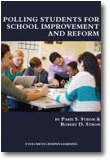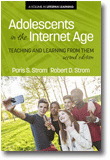Relevant Publications About Polling in Schools
Polling Students for School Improvement and Reform (P. Strom & R. Strom). Charlotte, NC: Information Age Publishing, 2016, 259 pp.

Adolescents in the Internet Age: Teaching Adolescents and Learning from Them, 2nd Edition (P. Strom & R. Strom). Charlotte, NC: Information Age Publishing, 2014, 444 pp.

Adolescent identity and career exploration (P. Strom, R. Strom, L. Whitten, & M. Kraska). NASSP Bulletin, March 2014, 1-17. DOI: 10.1177/0192636514528749
Thinking in Childhood and Adolescence (P. Strom & R. Strom). Charlotte, NC: Information Age Publishing, 2013, 346 pp.
Collaboration and support for student success (P. Strom, & R. Strom). Community College Journal of Research and Practice, June 2013, 37(8), 585-595.
Collaboration and support for student success (P. Strom & R. Strom). The Ed Digest, November 2013, 79(3), 50-56.
Cyberbullying: Assessment of student experience for continuous improvement planning (P. Strom, R. Strom, J. Wingate, M. Kraska, & T. Beckert). NASSP Bulletin, June 2012, 96(2), 137-153. DOI 10.1177/0192636512443281
Adolescent bullies on Cyber Island (P. Strom, R. Strom, J. Walker, T. Sindel-Arrington, & T. Beckert). NASSP Bulletin, 2011, 95(3), 195-211.
Examining stakeholder expectations for guiding school improvement: Including students (P. Strom, R. Strom, & T. Beckert). American Secondary Education, 39(3), Summer 2011, 5-16.
Cheating in middle and high school (P. Strom & R. Strom). In K. Ryan & J. Cooper (Eds.), Kaleidoscope: Contemporary and classic readings in education (12th edition) (pp. 49-56). Belmont, CA: Wadsworth Cengage, 2010.
Adolescent learning and the Internet: Implications for school leadership and student engagement in learning (P. Strom, R. Strom, C. Wing, & T. Beckert). The Ed Digest, February 2010, 75(6), 10-16.
Adolescents in the Internet Age (P. Strom & R. Strom). Charlotte, NC: Information Age Publishing, 2009, 619 pp.
Adolescent learning and the Internet: Implications for school leadership and student engagement in learning (P. Strom, R. Strom, C. Wing, & T. Beckert). NASSP Bulletin, 2009, 93(2), 111-121.
Polling students about conditions of learning (P. Strom, R. Strom, & C. Wing). NASSP Bulletin, December 2008, 92(4), 292-304.
Improving American schools: Perceptions of adults and students (P. Strom & R. Strom). In D. McInerney & A. Liem (Eds.), Teaching and Learning: International Best Practice (Volume 8 Research on Sociocultural Influences on Motivation and Learning) (pp. 111-132). Charlotte, NC: Information Age Publishing, 2008.
Curbing cheating, raising integrity (P. Strom & R.Strom). The Ed Digest, April 2007, 72(8), 42-50.
Cheating in middle school and high school (P. Strom & R. Strom). The Educational Forum, &1(2), Winter 2007, 104-116.
New directions for teaching, learning, and assessment (R. Strom & P. Strom). In R. Maclean (Ed.), Learning and Teaching for the Twenty-First Century: Festschrift for Professor Phillip Hughes. Support from UNESCO International Centre, Germany, with the Asia-Pacific Educational Research Association. New York: Springer Publishers, 2007, 115-134.
Minimizing cyberbullying (P. Strom & R. Strom). Kappa Delta Pi, online, 2006. Reprinted from The Education Forum, P. Strom & R. Strom, 2005, Cyberbullying by adolescents: A preliminary assessment, 70(1), 21-36.
Cyberbullying by adolescents: A preliminary assessment (P. Strom & R. Strom). The Educational Forum, Fall 2005, 70(1), 21-36.
When teens turn bullies (P. Strom & R. Strom). The Ed Digest (Issue: Creating Great School Climate), 2005, 71(4), 35-41.







